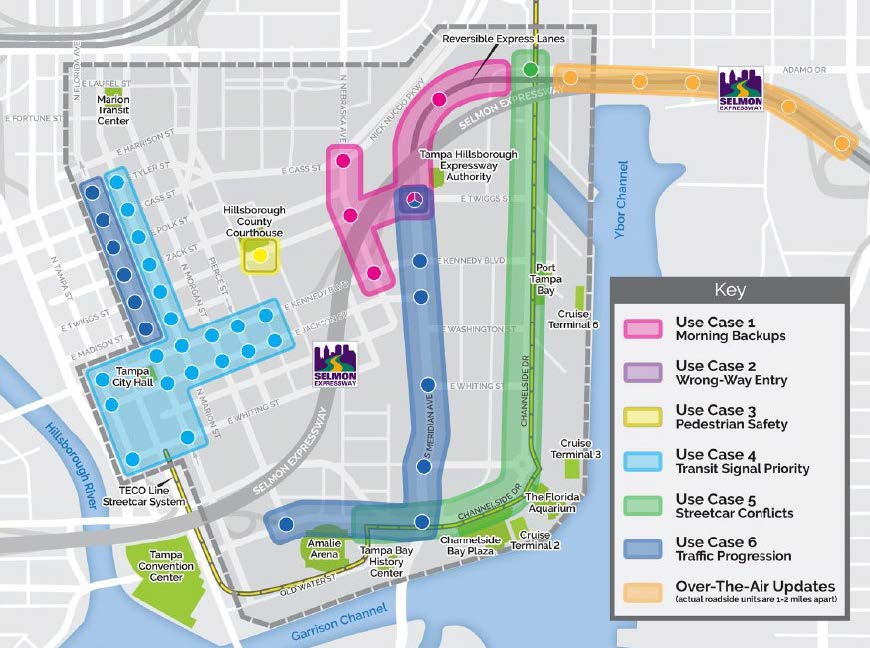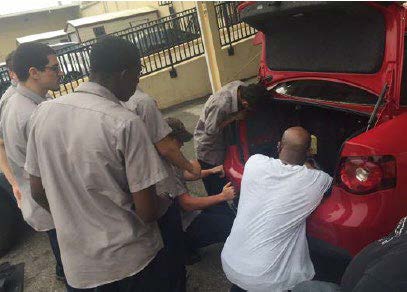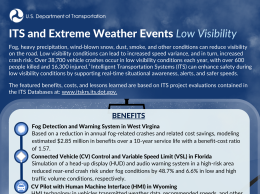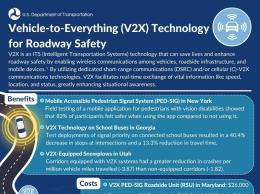Piloting Connected Vehicle Technology in Tampa's Central Business District
This case study discusses "Piloting Connected Vehicle Technology in Tampa's Central Business District." The project discussed in this case study is part of the Connected Vehicle Pilot Deployment Program.
IN THIS CASE STUDY YOU WILL LEARN:
- Why Tampa-Hillsborough Expressway Authority (THEA) was well-positioned to be an early deployer of connected vehicle (CV) technology
- How THEA created a built-in performance measurement system
- How THEA plans to make downtown Tampa a research testbed for future CV studies
Background
Under the aegis of the Connected Vehicle (CV) Pilot Deployment Program, the United States Department of Transportation (USDOT) Intelligent Transportation Systems Joint Program Office (ITS JPO) awarded cooperative agreements collectively worth more than $45 million to three pilot sites in New York City, Tampa, and Wyoming to implement a suite of CV applications and technologies tailored to meet their region’s unique transportation needs, ranging from dense urban grid networks to isolated high-plains interstates.
| According to THEA, the CV Pilot was an experimental project and, therefore, very different from construction projects typically undertaken. |
Tampa-Hillsborough Expressway Authority (THEA) owns, maintains, and operates four facilities within Hillsborough County, Florida which offers a variety of traffic, mobility, and safety situations that are amenable to connected vehicle solutions. THEA applied for the Program with hopes of deploying CV technology on and within the vicinity of the Reversible Express Lanes (REL), as well as other sections of downtown Tampa (see Figure 1) to help relieve congestion, reduce collisions with transit vehicles and pedestrians, and prevent wrong-way entry at the REL exit.
Becoming Technologically and Institutionally Ready
Supportive Business Model and Leadership Buy-In
Unlike the other two Pilot awardees (Wyoming Department of Transportation, WYDOT, and New York City Department of Transportation, NYCDOT), THEA is not a state or city agency. As an independent agency, THEA is financed solely through revenue bonds supported by user tolls, without using any tax funding. THEA’s non-conventional business model and focus on innovation naturally provided them with a level of flexibility and openness to research state-of-the-art technology. Additionally, THEA’s Executive Director and Board were strong champions for the deployment since day one, committing the team with the necessary resources to be successful.1

Diverse Partnerships
While THEA was well-positioned to lead such a project, the complexity of the Pilot required partnerships across multiple stakeholder groups from state and local agencies as well as the private sector. THEA’s major partners for the Pilot included the City of Tampa, Hillsborough Area Regional Transit Authority (HART), Hillsborough Community College, University of South Florida’s Center for Urban Transportation Research (CUTR), software and hardware suppliers, and various private contractors to support systems engineering, stakeholder outreach, and participant and staff training.
In addition to forming new partnerships, THEA also took advantage or existing partnerships. To oversee the infrastructure component of the deployment and lead the system integration effort, THEA brought on the hardware and software provider of the City of Tampa’s existing traffic management systems. In this respect, the project began with a well-established relationship. An advantage of this approach was that the infrastructure contractor was able to integrate the CV-enabled system design into its existing system design relatively smoothly.1
CV-Ready Infrastructure
To create the necessary backhaul network for the connected vehicle technology (see sample alerts from the technology in Figure 2), THEA had to install wireless modems along signalized intersections downtown. However, THEA had existing fiber along the REL prior to initiating the project. A key element of THEA’s infrastructure, the backhaul network also enabled the over-the-air (OTA) mechanisms that allowed software and firmware updates to be rolled out to the connected vehicles remotely. Enabling OTA updates was critical for THEA so that they would not need to inconvenience their participants by requiring them to bring in their vehicles for service whenever application software required updating.

In addition to the HART buses and streetcars that were retrofitted with the CV technology, THEA enlisted drivers of privately owned vehicles to participate in the study, giving the agency a unique opportunity to engage with the public. THEA sought the public’s participation in the pilot through a recruitment process that incentivized participant drivers in the form of a toll rebate along the Selmon Expressway. Following an extensive outreach campaign, THEA garnered the interest of 3,500 applicants, shattering their target goal of 1,600.2

Community Engagement and Cost Savings
In another unique arrangement, THEA took advantage of an opportunity to cut program costs and benefit the community by having local students provide key services for the program (see Figure 3). Through a partnership with Hillsborough Community College (HCC), THEA was able to leverage the facilities and students associated with HCC’s Master Mechanic Program. Students installed the onboard CV equipment (including the rearview mirrors that displayed the safety alerts to drivers) into the 1,000+ participant vehicles.2 Through this synergy, students were able to fulfill their graduation practicum requirements and experience new technologies firsthand, while THEA reaped significant savings on installation costs.
Building an Evaluation Framework
The CV Pilot sites were contractually required to support an evaluation effort that assessed the impact of the deployment on a set of key performance measures associated with the motivating needs underlying the deployment. The panel of participants was split into treatment (HMI-enabled) and control (HMI-disabled) groups using a randomized two-to-one matching (two treatment to one control) based on key socio-demographics. A “before & after” assessment and interrupted timeseries analysis was then used to analyze behavioral responses to the CV technology.3
THEA and CUTR, the Performance Evaluation Lead for the THEA Pilot, strategically selected performance measures that ascertained the effectiveness of its use cases (see Figure 1) based on the four pillars of safety, mobility, environment, and agency efficiency. However, when it came to setting evaluation goals, the team purposely avoided setting arbitrary target numbers, as they were more focused on achieving general benefits. For THEA, even preventing one crash was something they would be proud of.3
Using their selected metrics, CUTR was able to create a built-in performance measurement system that automatically captured relevant vehicle information, fused it with additional contextual data (i.e., Bluetooth reader, weather, event logs, and HART data), and output summary dashboards that kept both the project team and stakeholders informed of the status of the connected vehicle network (see Figure 4).
Post-Pilot Collaboration with Auto Manufacturers
While the main motivation for the project was to reduce incidents and congestion in downtown Tampa, THEA was also eager for the opportunity to position Tampa for the next phase of smart infrastructure development and to act as a research testbed where agencies and vendors can develop and test new connected vehicle applications.
| Under the next phase of the project, THEA will work to integrate onboard technology from multiple auto manufacturers to show how connected vehicle technology can be incorporated into vehicles coming off the line.4 |
When the project’s original 18-month operational period wrapped up in September 2020, THEA wanted to sustain the capability and expand some of the functionality of the system. Through an extended phase of the original cooperative agreement, THEA is currently partnering with the Original Equipment Manufacturer (OEM) community (including Hyundai, Honda, and Toyota) within the original deployment area to support spectrum testing activities that are focused on the criticality of ensuring spectrum availability with no harmful interference.4 Under this arrangement, the OEM vehicles will not only interact with one another but also with the existing CV Pilot participants, demonstrating how OEM vehicles can be integrated into a pre-existing connected vehicle network. This collaboration is among the first of its kind and is the next step in making connected roadways a reality in Tampa, laying the foundation for the next generation of transportation systems.
References
- THEA CV Pilot Semi-Annual Institutional Assessment. Prepared by Texas A&M Transportation Institute. May 2020.
- From Design to Deployment: How THEA’s Pilot Moves Connected Vehicles from Theory to Reality. APWA R July 2019 Issue. https://issuu.com/apwa/docs/201907_reporteronline/1?ff%203
- THEA Deployment Results and Transition Plan Webinar. January 25, 2021. https://itsa.adobeconnect.com/_a932559885/p2l0lrudkpl7/?proto=true
- Next Phase of THEA’s Connected Vehicle Pilot Brings Together Auto Manufacturers and Road Operators. Release. Tampa Hillsborough Expressway Authority. October 15, 2020. https://www.tampa-xway.com/ne releases/


